Thank you for posting those photos, Taigh! I've got a photo of the cockpit of the K-10-NT in the Netherlands, and you can tell that they were very close to one another on the production floor, as the cockpit details (which changed with every production block) are identical between the two (including that rare stencil below the aileron trim wheel, that says 'Land Gear Down', with an arrow, which is not often seen). While the airframe that is "Second Fiddle" served as a state-side trainer during WWII and would have likely just retained the factory-installed N-9 reflector gun sight, the example in the Netherlands, which is said to have been part of the 78th FG, shows signs of having had a K-14 gun sight installed in the field (which it no longer has).
Andy, I too am really looking forward to Midwest Aero's latest. According to Warbird Digest, that particular project (44-63576) switched owners rather recently (now owned by Jon Vesely) and so a different paint scheme is in mind it sounds like. They say that it is hoped that the aircraft will be flying early this summer.
One project that should absolutely gobsmack anyone who hasn't already been following it, is the restoration of the combat vet "Sierra Sue II" at Aircorps Aviation. Everything on this project is being done to recreate the look of the original production (part by part, rivet by rivet), and to have the aircraft configured exactly as it was during the war, an early production P-51D-20-NA. Unlike any other P-51 restoration that has come before, parts and assemblies are being primered/painted in the order that they originally did. The result is the type of over-spray that you see in original production, rather than a perfect uniform finish. Many parts when primered were simply dipped, so in the restoration you see the same type of runs in the primer that you do in the original un-restored parts. For the rivets being used for the project, they are reproduced to match the original finishes, including clear-anodized, blue-anodized, and iridite (which has a yellowish finish) - on the shop floor, the use of these rivets was random, from one to the next, because the anodized and iridite rivets were just poured together, and this authentic random pattern of silver/yellow (and sometimes blue) rivets over the airframe can be seen in this restoration. Like as was done with 'Happy Jack's Go Buggy' and several restorations since then, the original Alclad manufacturer's watermarks are found recreated on the skins, and in places where spot welding occurred, acid is brushed onto the metal (as done at the factory to quickly clean the metal before welding).
For comparison with the Crawford P-51K cockpit which Taigh very kindly posted photos of above, here's a photo of the cockpit of her sister in the Netherlands (note the cut-out in the instrument panel shroud, which was a common modification with K-14 installations to move the gun sight forward more, away from the pilot's head a bit -this aircraft would have originally come from the factory with an N-9 installed, but as mentioned shows signs of having had a K-14 installed while in service):






